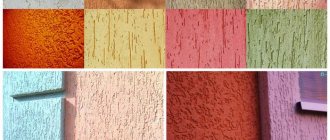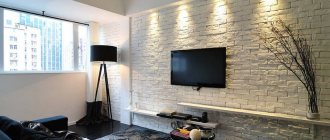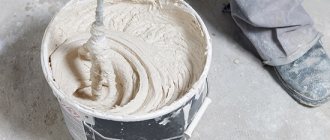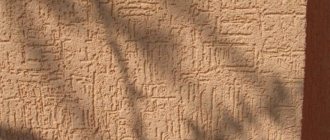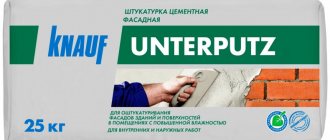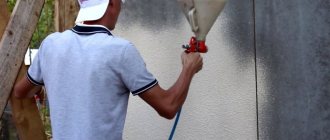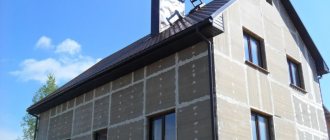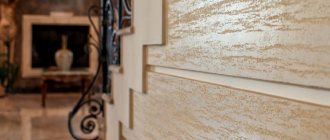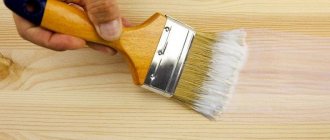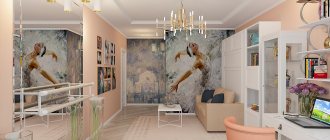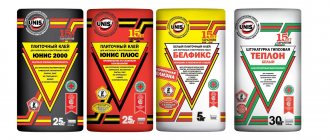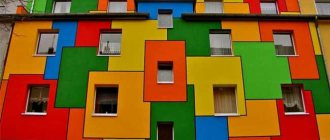Finishing external walls is a responsible undertaking, which is designed to create a protective layer and an attractive appearance. One of the most popular methods is plastering facades. This method does not require professional skills or the use of complex equipment. The material for the work has an acceptable cost, which is significantly less than what is needed for other types of cladding.
The advantages of decorative plaster include the following:
- High environmental properties.
- A huge variety of colors, textures, application methods.
- A simple application technique that even a person with no experience can handle.
- Aesthetic, high-quality result of the work performed.
- Durability, maximum immunity to external aggressors (rain, wind, ultraviolet radiation, sudden temperature changes).
- Unpretentiousness in further use.
Among the disadvantages of cladding, the following factors should be mentioned:
- Shorter service life compared to cladding with brick, clinker, and ventilated facades.
- Large time and energy costs required to finish the entire house. Because of this, in most cases it is necessary to use the services of hired teams.
- The need to carefully select the type of plaster depending on the material of the wall being treated.
- There is a chance of running into hackers who will perform work in violation of technological requirements. This can lead to not only a reduction in the service life of the facade, but also partial destruction of the main wall. For example, when using the wrong material for cladding a façade made of breathable aerated concrete.
Grinding cement-sand plaster
After several hours after leveling the surface, the wall is rubbed with a floor polisher or grater in a circular motion . This method will make it possible to remove all errors and flaws that appeared during the plastering process . If necessary, this technique can be repeated a day later.
| If the application of the cement-sand mortar coincides with the hot season, it is necessary to ensure that the material is watered. Thanks to this process, the plaster will dry evenly and will not crack. If cracks do appear in some places, they need to be smoothed out with a grater. |
How does façade differ from ordinary plaster?
Facade plaster comes into contact with winds, rain and snow, and “collides” with ultraviolet radiation and chemicals. Sometimes, the outer covering takes on the blows of objects crashing into it. Therefore, plaster for facade work should be:
Exterior view of a house finished with facade plaster
- Waterproof. Otherwise, the coating will swell, begin to fall off, become moldy, and lose its aesthetics. Indoors, plaster is often used without moisture protection, since there is a minimum of vapor in the air. The exceptions are bathrooms and swimming pools.
- Durable. Mechanical loads on the facade are rare. However, the potential for impacts poses a threat. For example, a car will not crash into interior walls. A lamppost will not fall in the rooms, and the ball is unlikely to fly from a 100-meter distance, having time to accelerate to its maximum. To eliminate such risks, manufacturers focus on the strength of façade coatings.
- Resistant to temperature changes. There is always a positive indicator in the home. It is customary to maintain a comfortable living temperature of 20-25 degrees Celsius. Outside the situation is different. The building can almost melt, or it can take the blow of icy cold. Facade plaster for external use must withstand temperatures from -40 to +45 degrees. For arctic and desert regions, specialized lines with a wide range of operating temperatures are produced.
- Vapor permeable. This property is popularly called the breathing of building materials. Vapor permeability allows the coating to allow air to pass through. This eliminates the accumulation of condensation and maintains a healthy microclimate inside the building.
- Heat and sound insulating. The coating serves as additional protection for the structure, including from frost and noise. In order for them to “stick” in the plaster, it has closed internal pores. Closed capsules are filled with gas. It transmits both noise and temperature waves poorly. For a significant effect, a thick layer of plaster is needed. Therefore, its heat and sound insulating properties are only auxiliary, additional to the main ones.
- Plastic. It is more difficult to apply coating to facades, especially high ones and complex shapes, than to apply coating to indoors. Therefore, plasters for external use are made to be expressly plastic. This makes the decorating process easier and the finish adheres to the base.
- Diverse. For facade plaster, decorativeness is especially important. The covering becomes the face of the building, representing its style. Therefore, decorative finishing is needed. Facade plaster can always be tinted; it already contains color pigment or design particles such as sparkles, mineral chips, shells.
- UV resistant. Solar radiation has a destructive effect not only on living tissue, but also on building materials. In particular, they fade. Therefore, special pigments are added to plasters for exterior finishing. In addition, plasticizers that are resistant to sun rays are added, as if they are locking and enveloping dyes.
Facade plaster bark beetle
Naturally, facade plaster must have high adhesion. This is the property of adhesion to the base, penetration into its smallest cracks and pores. This way the coating reinforces the lower material and adheres to it better.
Spiral application of bark beetle
You can also combine different directions for applying bark beetle plaster
By making circular movements of the tool along the surface of the facade during the plastering process, you can achieve the effect of a spiral arrangement of grooves, because the pebbles will stretch according to the movements of the tool along the wall. Facade paint of any shade can be applied over decorative plaster. Acrylic based paint is best suited here . All plaster manufacturers recommend painting. But for some time the facade can be left unpainted; this will not harm the “bark beetle.”
Varieties of mixture
Let's consider the main types of plaster for facades, differing in composition and characteristics.
Acrylic
The function of the binding component in such a material is performed by acrylic resin, which allows the mixture to be sold in a state prepared for application. The applied plastic layer begins to set after a couple of hours, the surface becomes impact-resistant, vapor-permeable, and resistant to negative influences.
This plastering material for facades contains components that prevent the development of bacteria.
Silicate
The binder in this composition is liquid potassium glass. It is distinguished by a neutral indicator of electrostaticity, which provides protection against the accumulation of contaminants on the surface. Silicate material has good vapor permeability and creates an excellent alternative to acrylic compositions when their use is impossible.
Silicone
This material for exterior decoration is considered expensive, but has undeniable advantages - a rich color palette, elasticity, and is easy to wet clean.
A façade plastered with this composition easily allows steam to pass through, allowing the walls to “breathe.”
Mineral
The main component is a cement material, which creates an unprecedented strength indicator. On the building materials market, such plaster for external use is sold in the form of a dry mixture, which remains to be mixed with water, observing the ratios. The operational period of the finishing exceeds ten years, the material practically does not absorb water and resists the development of microbes.
If you use this option, you will have to paint it with facade paint that is resistant to low temperatures. Paintwork materials are used only on a silicate basis so that the plaster layer can breathe.
Terrasite
A type of decorative material for plastering facades, made on a cement-sand base with the addition of lime, mica and fine marble. The coating is durable and moisture-resistant, looks interesting, and lasts a long time. There is a labor-intensive process of applying the material and a long hardening period.
Cork
This type of plaster is gaining popularity among fans of eco-style. The composition contains natural oak bark, mixed with modifiers and binding components and creating the characteristics of a cork of natural origin. The coating is distinguished by its unique appearance, softness, antistatic characteristics, elasticity and environmental safety. Applied to walls made of aerated concrete, expanded clay, wood, and plastic.
Thermal insulating
It is used for external walls, the insulating material of which cannot cope with the functions assigned to it, and the frame base of the structure will not withstand additional protection from heat loss.
The composition of such facade plaster includes sawdust, polystyrene foam balls, verculite and other materials.
Soundproof
This plaster is used instead of auxiliary materials, combining it with mineralized wool or polystyrene foam. In combination with such insulation, the plaster layer protects against extraneous noise.
A cement-based plaster mortar; slag, pumice or magnesite are used as additional components to create a porous surface texture and sound absorption.
Decorative finishing with polystyrene foam - features and technology
Expanded polystyrene (foam plastic) is a construction and finishing material that has excellent thermal insulation qualities and can advantageously transform the facade of a house. In addition, it is lightweight, which does not place additional load on the foundation of the building.
The technology of façade finishing with polystyrene foam involves 2 methods:
- The principle of a “wet facade”, where the slabs act as insulation, which is mounted on the wall and plastered using one of the previously listed methods.
- Partial use as a decorative element. Thermal insulation qualities are not used in this case.
Let's consider the features of the decorative use of polystyrene foam on facades. Its installation can be carried out on already coated surfaces or on those that have passed the leveling stage. In the first case, decorative elements are glued and painted on site. In the second, they are processed together with the rest of the surface, then painted.
Facade stucco molding made of polystyrene foamSource www.dizainvfoto.ru
Decorative elements made of polystyrene foamSource thewalls.ru
Decorative rustics on the facade of the houseSource thewalls.ru
In fact, decorating a façade with polystyrene foam involves distributing finished elements over its surface. The front surface of each of them is reinforced with an acrylic fiberglass mesh with a protective layer of cement-adhesive composition applied. All you have to do is paint it the desired color and stick it on the wall in the right place.
The variety of decor options for a polystyrene foam façade allows you to turn an ordinary house into an elegant cottage built according to an architectural design of the 19th century. Some of the most popular decorative elements include:
- Columns - rectangular or round in cross-section and come in a variety of sizes and styles. They are made according to the classical principle, in the form of three components: base, body and capital.
- Pilasters - outwardly similar to a column, but in fact they are only a decorative protrusion.
- Facade cornices - used as a delimiter between floors or separating the cornice from the roof.
- Horizontal profiles separating different levels of a building.
- External and internal corners for clearly marking the boundaries of the house.
- Window elements (casing, profiles installed at the base of openings, upper arches).
- Full U-shaped or vaulted arches.
- Other decorative elements: rosettes, balustrades, balusters, cornerstones or keystones, imitation of popular finishing materials.
Facade decorated with decorative stucco molding made of polystyreneSource kcdn.kz
Cladding the walls of a house with foam plastic decor Source vse-otoplenie.ru
Decorating a cottage with polystyrene foam slabsSource productiondecor.rf
Tips and tricks
The undoubted advantage of ready-made building mixtures is their quality and proper combination of all components. However, preference should be given to products manufactured by trusted manufacturers.
New materials must be treated with caution. As a rule, the high cost of such a mixture will be justified by the ease of use of the composition, as well as economical consumption
It is very important to make large purchases of building materials only from reliable suppliers. This will help you avoid purchasing counterfeits of well-known brands.
Regarding use on different surfaces, experts recommend the following:
- wooden walls are plastered with a cement-lime composition using lathing;
- for foam concrete it would be preferable to purchase a gypsum mixture;
- brick walls do not require the application of a special composition.
To make sure that the purchased product is truly of high quality, you can check its packaging. The dry plaster mixture in the bag will have a film between the outer and inner layers of the package. The release time of the composition applied to the bag should not be the same. To increase the plasticity of the plaster mixture, it is recommended to add a little detergent to the water. For work with surfaces that have significant curvature, it is best to use plaster beacons.
By carefully studying the characteristics of each type of plaster mixture, you can easily make the right choice.
See below for a comparison of plaster from different manufacturers.
Consumption of working mixture for facades, how to estimate
Before starting external work, it is necessary to determine how the working mixture will be consumed. On average, plastering one square meter will require 2-4 kilograms of mixture. To more accurately determine the solution consumption, two factors are taken into account:
- Type of solution used. For plastering facades, silicone, mineral and acrylic mixtures with different consumption rates are used. Manufacturers of such formulations indicate on the packaging information about the costs of each of them.
- The material from which the wall is made. Most of the mortar is consumed when working with brick walls. This surface is the most prominent due to the gaps between the bricks and therefore more working mixture will be needed to plaster it.
Technology of applying facade plasters to different surfaces
Before applying facade plaster, it is important to properly prepare the base. The most important thing is that the surface should be smooth and without major defects.
Also, regardless of the quality and evenness of the wall structures, it is necessary to create a base reinforcing layer with a mesh on their surface to provide a strong and durable base for decorative finishing.
Photo 3. Formation of the “Lamb” texture by grouting
Techniques for plastering with decorative textured compositions:
- Application is carried out using a spatula or trowel.
- The solution is applied in small areas, since after 10-20 minutes you need to grout.
- Grouting is carried out to give the coating a certain texture (depending on the plaster used). Usually done with a plastic grater using circular movements until the desired decorative effect is achieved.
The technology for applying facade plaster using the example of a mixture of the “Bark Beetle” type is shown in more detail in the following video:
Finishing facades made of aerated concrete
Facade plaster for external use is not simply applied to aerated concrete walls, even if the masonry is well done and does not require leveling. The walls must first be plastered with a special adhesive mixture with reinforcing fiberglass mesh. Only in this case you are guaranteed to receive a strong and durable coating.
Photo 4. The process of plastering walls and aerated concrete with fiberglass mesh reinforcement
Facade plaster using polystyrene foam, penoplex and mineral wool
The facade mixture is also not applied directly to expanded polystyrene or mineral wool. Initially, it is necessary to reinforce the thermal insulation layer using a special solution and reinforcement with fiberglass mesh, as required by the technology for insulating building facades.
Photo 5. Reinforcing plaster of a house facade insulated with polystyrene foam
Plastering the facade on a wooden base
With wooden walls the situation is much more complicated, since dry plaster mixtures for external use, as well as ready-made ones, have low adhesion to lumber and other wood-based substrates
Here it is important to properly prepare the base for plastering. Preliminary preparation of a wooden facade for applying decorative plaster involves performing the following work:
Preliminary preparation of a wooden facade for applying decorative plaster involves performing the following work:
Elimination of all defects - special attention is paid to areas of rot and areas affected by fungus and mold.
Complex surface treatment with hydrophobic and antiseptic impregnations.
Upholstery of the facade with shingles to ensure strong adhesion of the plaster to the wood.
Plastering with ordinary cement-sand mortar to create a solid base for the decorative mixture.
Only after these measures and hardening of the leveling plaster layer with shingles can you begin to apply the base reinforcing layer and textured facade plaster.
Photo 6. Plastering over shingles
Brick façade finishing
It is also advisable to apply a leveling plaster layer to brick walls. If they are perfectly smooth and do not need leveling, you can immediately apply a thin layer of the base reinforcing compound with a mesh. After the initial plastering and hardening of the coating, either dry plaster for exterior use is mixed with water in the proportions specified by the manufacturer, or it is taken ready-made in a bucket and applied to the base.
Advantages of plastering
Finishing the facade of a house with plaster has many advantages that explain its popularity:
- The coating prevents the penetration of moisture, which has a destructive effect. This does not create barriers to normal vapor exchange, which allows the walls to breathe.
- The outer layer provides additional sound and heat insulation. This is achieved through additives that improve the characteristics of the mixture.
- Decorative appeal. Various types of products and technologies can be used for cladding, which make it possible to obtain texture and the desired color. The plaster mixture can be tinted well.
- Elasticity. Compositions with a polymer component have this property. Due to this quality, the coating does not collapse due to shrinkage of the building and temperature changes.
Modern polymer compositions have unique performance characteristics and enviable beauty - Easy to install. Finishing facades does not require complex mathematical calculations and the construction of a frame.
- Possibility of repair. Any damage can be easily repaired. But if they make up more than 30% of the surface, this means an incorrect choice of composition or violation of application conditions.
All advantages are supported by the affordable price of the material, even taking into account the purchase of modern polymer solutions.
Simple DIY decoration.
Mineral homemade plaster mixtures are applied to the wall and leveled. The top is finished with a decorating layer of the same composition.
Alignment.
First coat of exterior plaster. Apply up to 1.5-2cm thick to give the wall perfect evenness. If you have to apply more significant layers, they must be reinforced.
Sometimes the exterior finish is applied in several thick layers, drying each one to avoid reinforcement. However, the reliability of layering is low: uneven thickness of the plaster is one of the main reasons for cracking of the exterior finish.
Decoration.
The second layer is textured. It is applied with various tools, depending on the desired relief, its nature, pattern and volume.
- Fur coats are obtained by working with a roller. To do this, the solution is made liquid and the preparation to be decorated is “painted” with this composition.
- Small coats are obtained by spraying the walls with a liquid solution using a brush. It is dipped in the composition and, directed to the desired section of the wall, passed along the pile with a hard object. The straightening fibers (line) of the brush “shoot” the plaster mixture.
- The stone texture is an imitation of the natural irregularities of natural minerals. It is applied as a second layer with a trowel or embossed material (a crumpled piece of fabric, fur, cellophane).
The layer is not laid completely, but partially, in small fragments between which gaps of the first layer remain. When the solution begins to set, it is “lubricated” with the tool.
The proportions of the solution for the decorative layer of plaster on external walls do not change. The array must be homogeneous.
Imitation of stonework.
It is especially popular for finishing plinths, supports, pillars, and fences.
A simple way to decorate exterior plaster with your own hands is to apply an imprint. Special molds having the relief of the masonry are pressed into the fresh exterior plaster. After drying, it is painted, giving the “stones” a more natural look.
In order not to purchase prints, you can limit yourself to creating a relief by sampling it in wet plaster. Rows of masonry and individual shapeless or hewn stones in it are marked on the wall. Select the solution to the required depth with the corner of a spatula or other convenient tool. This technique requires a certain aptitude for fine art.
Preparing the walls
Before starting finishing plastering work, the wall surface is leveled by applying rough plaster. After it has completely dried, putty is applied to the wall and the surface is treated with a primer.
We also recommend that you find out what facade finishing with fur coat is on our website.
In order to prevent the joining points from being visible, the surface of the wall is divided into grips. They try to place their edges under any protruding elements (pilasters, slopes, internal corners, etc.).
Varieties
Cement-based facade plaster has two varieties:
- sandy;
- limestone.
The solutions differ in composition. For the first type I use only classic ingredients, and in the second, lime is added to them, which has an enhancing effect.
Cement-sand
Cement sand plaster is a budget option and has excellent durability and stability. Its basis is cement, the marking of which varies between M150–M500.
In addition to the main component, sand is also present. A simple mixture is used for rough finishing, wanting to level the surface. The improved type of coating is applied three times, grinding the finishing layer with a special grater. Elite mixtures are applied 5 times over the beacons, finishing with a covering to obtain ideal quality.
Cement-lime
When comparing cement facade plaster for exterior use, which contains an additive in the form of lime, with a conventional mixture, it should be understood that the former has improved strength characteristics. When preparing such a solution yourself, before using it, the lime must be quenched with water and then left for about a week. This event will protect the coating from blistering on the wall.
Do-it-yourself ready-made cement plaster for exterior use includes the following ingredients:
- sand;
- slaked lime;
- Portland cement;
- polypropylene fiber;
- additives that prevent moisture penetration.
The finished mixture is sold in dry form; you should prepare it yourself. The advantages of such a solution, optimal for application to facade walls, are as follows:
- versatility;
- high degree of adhesion;
- plastic;
- resistance to the formation of fungi and mold;
- wear resistance;
- long shelf life even after some time after preparation;
- the surface remains permeable to steam.
Flaws:
- low parameters for reducing compressive strength;
- costs more.
Construction of the reinforcing layer
Reinforcing
The layer is created by gluing a special fiberglass reinforcing mesh onto the heat insulator.
Installation of reinforcing mesh on slopes
To reinforce the slopes, use a special corner with a reinforcing mesh, which is placed on a 3-4 mm layer of the adhesive mixture and embedded using a poluter.
Installation of reinforcing mesh on the walls of a building
In order to mount a fiberglass mesh, a 2-3 mm layer of adhesive mixture is applied to the surface, then a reinforcing mesh is applied and embedded with a grater or trowel.
How to choose?
When choosing plaster, you should take into account the climatic conditions of the building, its purpose, and the type of working base.
To provide additional heat to the building, pay attention to compositions containing foam glass, perlite, and vermiculite. In regions with high humidity, the moisture-resistant characteristics of the plaster should be maximum
The so-called “winter” or frost-resistant version is optimal for northern regions. For those who want to repair the facade as rarely as possible, acrylic (service life is up to 25 years), silicone and silicate (service life is 15-20 years) compositions are suitable. Cement compositions have the least durability; their service life is 10 years.
Long-term preservation of functionality and aesthetic appeal is associated with the texture of the plaster
Smooth and smooth surfaces are more susceptible to cracking, while rough ones are not only more durable, but also hide minor surface imperfections. When purchasing plaster, it is important to understand how well it matches the type of wall. Otherwise, even an expensive and high-quality composition will not fulfill its functions.
So, for brick it is better to use cement or silicone compounds, and for aerated concrete - silicate or silicone. For the frame structure, choose an elastic acrylic mixture. Wood will accept silicate plaster well, and it is recommended to apply acrylic plaster on top of the reinforcing mesh on insulation boards.
In addition, when plastering a wooden building, you will need to ensure the presence of a special mesh with large cells or a shingle frame. Cement mortars are universal - suitable for all types of walls, including cold and damp basements. If installation is intended on the surface of the insulation, a reinforcing mesh is first laid.
All plasters are divided into 2 types:
- thick-layer – silicate and cement mortars;
- thin-layer – these include acrylic and silicone containing mixtures.
The use of the latter type of solution requires careful preparation of working substrates - cleaning, leveling.
The ready-made mixture is more convenient to transport and use (there is no need to calculate the ratio of parts of the composition and water, or mix the solution), but it is more expensive than dry mixtures. In addition, this form is not possible for all types of plaster.
Finishing with plaster can be an expensive pleasure, so always take into account the material consumption per 1 square meter. m. This will help not only to get an idea of the total cost of the mixture, but also to correctly calculate its required volume.
In general, consumption consists of factors such as the type of filler and binder, as well as the type and evenness of the working base.
On average, for different types of plaster the consumption is as follows:
- acrylic-based compositions – 1.5-3 kg/m2;
- silicone compounds – 2.5-3.9 kg/m2;
- mineral plasters – 2.5-4 kg/m2.
Having calculated the volume of material required for work, add another 5% to it. These are the so-called working losses. In the absence of such an increase, you risk finding yourself in a situation where there is not enough mixture and you have to buy more, selecting the desired shade. In this case, construction will be suspended.
When choosing a material, not only its functional but also its aesthetic characteristics are important. It is logical that users want the color to last as long as possible.
The durability of the color coating is determined by several factors:
- paint is applied over the plaster or color pigments are dissolved in the composition (the second option is preferable);
- antistatic properties of plaster, which determine the degree of surface contamination;
- resistance of color pigment to precipitation and UV rays.
The best result, based on the parameters discussed above, is demonstrated by silicone plaster. It does not attract dust, does not fade and is also characterized by a rich color palette. It is slightly inferior to silicate plaster, which cannot boast of such a variety of shades. Acrylic solution is subject to fading, in addition, it quickly becomes dirty. The worst indicators of color durability are demonstrated by mineral and cement coatings, which require almost annual painting.
Winter plaster – facade finishing using anti-frost additives
In addition to the fact that purchasing additives for plastering will speed up the completion date of the project, there are also a number of advantages and benefits of the materials:
- the plastic mass can be safely used in any region: after hardening, it can withstand from -50 to + 70⁰C without cracking from temperature changes;
- belongs to the category of water-repellent materials: precipitation and humid air will not harm smooth walls;
- will last much longer than simple plaster, which will have to be restored after 5 years; service life – from 10 to 25 years;
- dries quickly, the full period of contraction is a day, but within 2-3 hours the coating firmly adheres to the surface, and any weather vagaries are not able to prevent further drying.
As you can see, winter facade plastering is a profitable and promising business.
Types of facade plaster and their features
Exterior work on the facade of the house is carried out using the following types of building and decorative mixtures:
- Mineral compositions. They are based on cement, sand and additional polymer substances, which are used to improve the performance characteristics of the solution. The main advantages are high strength, reasonable cost, high vapor permeability, and environmental friendliness. The disadvantages include insufficient resistance to deformation; under their influence, the coating cracks.
- Acrylic plaster mixtures. Based on acrylic resin and synthetic binders. The advantages of this façade material include good resistance to temperature changes, elasticity, protection from fungi and mold, vapor permeability, and resistance to UV radiation. We also note a large selection of texture solutions - bark beetle, mosaic, pebble. The disadvantage is that it gets dirty quickly and therefore requires constant maintenance during operation.
- Silicate-silicone plaster. The material combines the advantages of silicone and silicate compounds and is characterized by high elasticity, vapor permeability, low water absorption and resistance to fungi. The solution is recommended for use as a finishing coating for thermal insulation systems for facades with mineral wool and polystyrene foam boards. The plaster material should be applied to walls made of brick or concrete using a stainless steel float, which is positioned at an angle of 60 degrees. The texture of the coating is formed with a plastic grater, which is held parallel to the surface being treated.
- Silicone-based decorative plasters have maximum durability, high strength and resistance to mechanical stress - the facade of the house is protected from cracks. In addition, the coating has self-cleaning properties - it repels dirt and dust, has elasticity and good vapor permeability properties. The main disadvantage is the high cost.
We plaster the walls according to the lighthouses
The distance between the profiles fixed to the wall should be 10 - 15 cm less than the length of the rule . To ensure that the outer profile slats are installed evenly, they are leveled. You can stretch threads between the profiles and install internal beacons along them.
Profiles and internal beacon between them
The cement-sand mortar is thrown onto the walls between the beacons manually and then leveled along the wall with a rule that is pressed tightly against the beacons. As a rule, according to the rule, the plastered surface has grooves and depressions that must be rubbed with a trowel or a special construction float. To make the work progress faster, a floor polisher is usually used.
Detailed video instructions telling how to plaster facade walls using beacons
Facade plastering technology
Façade finishing
The solution is prepared in accordance with the manufacturer's recommendations indicated on the packaging. If you are using a cement composition, then it must be diluted with water to the consistency of thick sour cream.
The finishing of the façade with plaster is carried out in three stages. The first is spraying. Using a ladle or trowel, pour the mortar onto the wall. Experienced plasterers add a little PVA glue to the cement plaster. This will add strength and improve grip. At this stage, do not strive for evenness; the mixture should lie on the wall in lumps. The layer of solution should be no more than five centimeters.
The second stage is applying the base layer. It is necessary to dilute the cement mortar to the consistency of liquid sour cream. Then also spray the second layer with a ladle or trowel. Then, using the beacons (if you use them, if not, then “by eye”), using zigzag movements from floor to ceiling, remove the excess and at the same time fill the resulting voids.
Mistakes when working with plaster
There are several common mistakes that beginners make when plastering facades. Among them are the following:
- Ignoring the primer. The walls must be primed first, as this improves the adhesion of the mortar. Without a primer, the plaster will begin to peel off faster.
- Incorrect preparation of the mixture. When creating the working mixture, you must follow the instructions on the packaging. A solution prepared inappropriately will not adhere well to the wall.
- Applying a thick layer. The coating should not be too thick so as not to sag under its own weight.
Plastering a facade is not an easy job that requires appropriate knowledge and skills. Every person who decides to do this on their own should become familiar with the features and methods of applying plaster.
Advantages of gypsum-based plaster mixture
Answering the question “is it possible to work with gypsum plaster outdoors?”, we confidently declare that finishing with this material is a real godsend for a novice craftsman. When working with such a mixture, you don’t have to worry about any mistakes made, because all the shortcomings are subsequently eliminated. The explanation is simple: the plaster mixture is easy to work with and can be easily ground off with a sharp spatula blade.
Modern gypsum-based plaster material ensures ideal evenness of the wall surface; additional application of starting and finishing material is not required.
The main advantages of this finishing material are:
- environmental cleanliness ensured by the natural origin of the main raw material (gypsum);
- absence of toxic components that emit specific odors;
- high rates of vapor and gas permeability;
- complete absence of such a phenomenon as shrinkage.
Horizontal and vertical application of bark beetle
It is generally accepted that the final texture of the surface plastered with bark beetle depends on the manufacturer and brand of the product. It is worth noting that this indicator also depends on the technique of applying the mixture by the master.
The application technique depends on the manufacturer of the plaster and the desired result.
If it is necessary for the furrows of the plaster to be placed horizontally, it must be applied in the same direction. To obtain vertical furrows, you need to change the direction of application.
By carrying out this process, you can understand and appreciate the need for high-quality preliminary plastering. If the cement plaster is applied evenly and rubbed well with a polisher, the relief structure of the “bark beetle” will be clearer. A unique relief is created by small pebbles in the plaster mixture, which create grooves due to friction between the wall and the surface.
Decorating the facade of the house
After the walls are leveled and the insulation is closed, you can begin to apply textured coatings. Consider frequently encountered textures:
Let's sum it up
Plastering facades is one of the simplest and most attractive finishing methods, accessible to even inexperienced builders. A large selection of colors and textures allows you to choose the appropriate option to suit your taste. All types of facades are available for finishing - brick, concrete and wood.
We hope that this article was useful to you. Leave your feedback and questions in the comments below. You can read more about decorative wall decoration on the pages of our website.
Source
conclusions
Nowadays, when plastering a house, the question arises not even of how, but with what to plaster the facade of the house - there are a lot of proposals. And by and large, all proposals are equally good, it all depends on the initial rough surface. Therefore, be sure to familiarize yourself with the specific conditions for implementing facade plastering and the materials used.
Check out the photos and additional video in this article. This is not possible without thorough preparation. The work itself - waterproofing, insulation, waterproofing again, mesh and two layers of plaster - is already a matter of technology.
Structural
Methods for applying decorative plaster to obtain a structure involve the use of heterogeneous granular compositions. A type of material is obtained by adding small pebbles, quartz fragments, wood fibers, etc. to the plaster. The finishing material is made from cement and limestone. Synthetic latexes or silicates are also added to the composition. It is better to select the composition from ready-made mixtures. This is the only way to achieve good results. When mixing the components yourself, a good result is not guaranteed.
To prepare high-quality plaster, it is better to use ready-made mixtures
Finishing walls with textured plaster is easier if you use compositions based on aqueous solvents. This is due to the fact that before applying decorative plaster with your own hands, you will not have to “evacuate” the apartment’s residents. The water-based material does not have a strong odor.
Finishing walls with plaster of this type is easy. This is due to the high ductility of the material and its obedience during operation. The technology for applying decorative plaster is simple and convenient. The work can be completed immediately. There is no need to prepare the mixture, since it is sold already in liquid form in jars or buckets.
Using decorative plaster you can create any structure in different shades
The application technique is as follows:
- You need to prepare materials and tools for decorative plaster. For the structural composition you will need a roller, trowel or spatula.
- Before laying decorative plaster, you need to prepare the surface. A perfectly flat base is not needed. The thickness of the plaster layer and its structure can hide small defects. First, the surface is cleaned of dirt, dust and grease. After this, the bulges are knocked down and large cracks and potholes are covered.
- A clean and dry base is strengthened with a primer. With it, decorative paints and plasters will adhere better to the surface. This layer also prevents the exchange of moisture between the base and the finishing material. You can begin applying decorative plaster yourself only after the wall primer has completely dried.
- The principle of the work performed is suitable for all compositions: mineral, silicone or silicate based. Plastering is carried out using a trowel or spatula in one layer. The coating is applied to the wall using circular or linear movements.
- After application, the layer must be allowed to dry. At the same time, it is necessary to control that the room maintains a constant temperature and humidity, and that there are no drafts. Failure to comply with these rules can lead to deterioration in the quality of the decorative layer and the appearance of cracks.
To apply the composition and create a structure, use a roller or spatula
Do-it-yourself structural decorative plaster of walls is perfect for finishing common rooms, for example, an entrance hall, a kitchen or a corridor. In some interiors, it can harmoniously fit into the space of a bedroom or living room.
Before starting work, be sure to read the manufacturer's instructions. It indicates a more specific application technique and how to use the material correctly.
Base plaster layer
The first layer, reinforced with mesh, will replace the frame on which the entire wet facade insulation system will be supported. The solution consumption is 15–20 kg/sq.m., the dry mixture is mixed according to the manufacturer’s requirements. The solution is applied with a special pump or spatula, periodically pressing the mesh to the inner layer.
If the mesh is deformed in some places and comes out of the solution with bulges, you need to correct the mistake and fix the problem area with a special nail. To reduce such accidents, it is better to apply the solution from the bottom up. The thickness of the first layer should be the same over the entire surface of the wall.
After applying the base plaster layer, it is recommended to maintain optimal humidity on the wall surface. In dry weather and high air temperatures, the plastered area will have to be moistened.
